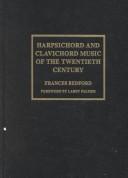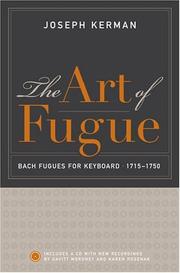| Listing 1 - 6 of 6 |
Sort by
|
Book
ISBN: 0253011647 9780253011640 130658244X 9781306582445 9780253011589 0253011582 Year: 2014 Publisher: Bloomington, IN Indiana University Press
Abstract | Keywords | Export | Availability | Bookmark
 Loading...
Loading...Choose an application
- Reference Manager
- EndNote
- RefWorks (Direct export to RefWorks)
Written by Joan Benson, one of the champions of clavichord performance in the 20th century, Clavichord for Beginners is an exceptional method book for both practitioners and enthusiasts. In addition to detailing the historical origins of the instrument and the evolution of keyboard technique, the book describes the proper method for practicing fingering and articulation and emphasizes the importance of touch and sensitivity at the keyboard. A CD featuring Benson in performance and a DVD of interviews and lessons accompany the book, illustrating important exercises for the beginner. The disk
Clavichord music --- Clavichord --- Keyboard instruments --- Instruction and study.

ISBN: 0914913190 Year: 1993 Publisher: Lanham London The Scarecrow Press
Abstract | Keywords | Export | Availability | Bookmark
 Loading...
Loading...Choose an application
- Reference Manager
- EndNote
- RefWorks (Direct export to RefWorks)
repertoires --- klavecimbelmuziek --- anno 1900-1999 --- 921 --- Repertoria - catalogi (bezetting) --- Clavichord music --- Harpsichord music --- Music --- 78.43.1 --- Art music --- Art music, Western --- Classical music --- Musical compositions --- Musical works --- Serious music --- Western art music --- Western music (Western countries)
Book
Year: 2015 Publisher: Berkeley, CA : University of California Press,
Abstract | Keywords | Export | Availability | Bookmark
 Loading...
Loading...Choose an application
- Reference Manager
- EndNote
- RefWorks (Direct export to RefWorks)
A free ebook version of this title is available through Luminos, University of California Press's new open access publishing program for monographs. Visit www.luminosoa.org to learn more. Fugue for J. S. Bach was a natural language; he wrote fugues in organ toccatas and voluntaries, in masses and motets, in orchestral and chamber music, and even in his sonatas for violin solo. The more intimate fugues he wrote for keyboard are among the greatest, most influential, and best-loved works in all of Western music. They have long been the foundation of the keyboard repertory, played by beginning students and world-famous virtuosi alike. In a series of elegantly written essays, eminent musicologist Joseph Kerman discusses his favorite Bach keyboard fugues-some of them among the best-known fugues and others much less familiar. Kerman skillfully, at times playfully, reveals the inner workings of these pieces, linking the form of the fugues with their many different characters and expressive qualities, and illuminating what makes them particularly beautiful, powerful, and moving. These witty, insightful pieces, addressed to musical amateurs as well as to specialists and students, are beautifully augmented by performances made specially for this volume: Karen Rosenak, piano, playing two preludes and fugues fromTheWell-Tempered Clavier-C Major, book 1; and B Major, book 2--and Davitt Moroney playing the Fughetta in C Major, BWV 952, on clavichord; the Fugue on ";Jesus Christus unser Heiland,"; BWV 689, on organ; and the Fantasy and Fugue in A Minor, BWV 904, on harpsichord.
Fugue. --- MUSIC / Genres & Styles / Classical. --- Fugue. --- 18th century fugues. --- 18th century music. --- bach. --- classical music. --- clavichord music. --- fugue in c major. --- fugue in c minor. --- fugues. --- harpsichord music. --- history of music. --- intimate fugues. --- keyboard composition. --- keyboard music. --- music appreciation. --- music composition. --- music theory. --- musical analysis. --- musical commentary. --- musical scores. --- musicology. --- organ music. --- organ toccatas. --- piano keyboard. --- studies in classical music. --- technical music analysis. --- the well tempered clavier. --- Bach, Johann Sebastian, --- Keyboard music (Bach, Johann Sebastian) --- 18th century fugues. --- 18th century music. --- bach. --- classical music. --- clavichord music. --- fugue in c major. --- fugue in c minor. --- fugues. --- harpsichord music. --- history of music. --- intimate fugues. --- keyboard composition. --- keyboard music. --- music appreciation. --- music composition. --- music theory. --- musical analysis. --- musical commentary. --- musical scores. --- musicology. --- organ music. --- organ toccatas. --- piano keyboard. --- studies in classical music. --- technical music analysis. --- the well tempered clavier.
Book
Year: 2015 Publisher: Berkeley, CA : University of California Press,
Abstract | Keywords | Export | Availability | Bookmark
 Loading...
Loading...Choose an application
- Reference Manager
- EndNote
- RefWorks (Direct export to RefWorks)
A free ebook version of this title is available through Luminos, University of California Press's new open access publishing program for monographs. Visit www.luminosoa.org to learn more. Fugue for J. S. Bach was a natural language; he wrote fugues in organ toccatas and voluntaries, in masses and motets, in orchestral and chamber music, and even in his sonatas for violin solo. The more intimate fugues he wrote for keyboard are among the greatest, most influential, and best-loved works in all of Western music. They have long been the foundation of the keyboard repertory, played by beginning students and world-famous virtuosi alike. In a series of elegantly written essays, eminent musicologist Joseph Kerman discusses his favorite Bach keyboard fugues-some of them among the best-known fugues and others much less familiar. Kerman skillfully, at times playfully, reveals the inner workings of these pieces, linking the form of the fugues with their many different characters and expressive qualities, and illuminating what makes them particularly beautiful, powerful, and moving. These witty, insightful pieces, addressed to musical amateurs as well as to specialists and students, are beautifully augmented by performances made specially for this volume: Karen Rosenak, piano, playing two preludes and fugues fromTheWell-Tempered Clavier-C Major, book 1; and B Major, book 2--and Davitt Moroney playing the Fughetta in C Major, BWV 952, on clavichord; the Fugue on ";Jesus Christus unser Heiland,"; BWV 689, on organ; and the Fantasy and Fugue in A Minor, BWV 904, on harpsichord.
Fugue. --- Bach, Johann Sebastian, --- Keyboard music (Bach, Johann Sebastian) --- 18th century fugues. --- 18th century music. --- bach. --- classical music. --- clavichord music. --- fugue in c major. --- fugue in c minor. --- fugues. --- harpsichord music. --- history of music. --- intimate fugues. --- keyboard composition. --- keyboard music. --- music appreciation. --- music composition. --- music theory. --- musical analysis. --- musical commentary. --- musical scores. --- musicology. --- organ music. --- organ toccatas. --- piano keyboard. --- studies in classical music. --- technical music analysis. --- the well tempered clavier.
Book
Year: 2015 Publisher: Berkeley, CA : University of California Press,
Abstract | Keywords | Export | Availability | Bookmark
 Loading...
Loading...Choose an application
- Reference Manager
- EndNote
- RefWorks (Direct export to RefWorks)
A free ebook version of this title is available through Luminos, University of California Press's new open access publishing program for monographs. Visit www.luminosoa.org to learn more. Fugue for J. S. Bach was a natural language; he wrote fugues in organ toccatas and voluntaries, in masses and motets, in orchestral and chamber music, and even in his sonatas for violin solo. The more intimate fugues he wrote for keyboard are among the greatest, most influential, and best-loved works in all of Western music. They have long been the foundation of the keyboard repertory, played by beginning students and world-famous virtuosi alike. In a series of elegantly written essays, eminent musicologist Joseph Kerman discusses his favorite Bach keyboard fugues-some of them among the best-known fugues and others much less familiar. Kerman skillfully, at times playfully, reveals the inner workings of these pieces, linking the form of the fugues with their many different characters and expressive qualities, and illuminating what makes them particularly beautiful, powerful, and moving. These witty, insightful pieces, addressed to musical amateurs as well as to specialists and students, are beautifully augmented by performances made specially for this volume: Karen Rosenak, piano, playing two preludes and fugues fromTheWell-Tempered Clavier-C Major, book 1; and B Major, book 2--and Davitt Moroney playing the Fughetta in C Major, BWV 952, on clavichord; the Fugue on ";Jesus Christus unser Heiland,"; BWV 689, on organ; and the Fantasy and Fugue in A Minor, BWV 904, on harpsichord.
Fugue. --- MUSIC / Genres & Styles / Classical. --- Fugue. --- Bach, Johann Sebastian, --- Keyboard music (Bach, Johann Sebastian) --- 18th century fugues. --- 18th century music. --- bach. --- classical music. --- clavichord music. --- fugue in c major. --- fugue in c minor. --- fugues. --- harpsichord music. --- history of music. --- intimate fugues. --- keyboard composition. --- keyboard music. --- music appreciation. --- music composition. --- music theory. --- musical analysis. --- musical commentary. --- musical scores. --- musicology. --- organ music. --- organ toccatas. --- piano keyboard. --- studies in classical music. --- technical music analysis. --- the well tempered clavier.

ISBN: 0520287630 0520962591 9780520962590 0520243587 9780520243583 9780520287631 Year: 2015 Publisher: Oakland, California University of California Press
Abstract | Keywords | Export | Availability | Bookmark
 Loading...
Loading...Choose an application
- Reference Manager
- EndNote
- RefWorks (Direct export to RefWorks)
A free ebook version of this title is available through Luminos, University of California Press's new open access publishing program for monographs. Visit www.luminosoa.org to learn more. Fugue for J. S. Bach was a natural language; he wrote fugues in organ toccatas and voluntaries, in masses and motets, in orchestral and chamber music, and even in his sonatas for violin solo. The more intimate fugues he wrote for keyboard are among the greatest, most influential, and best-loved works in all of Western music. They have long been the foundation of the keyboard repertory, played by beginning students and world-famous virtuosi alike. In a series of elegantly written essays, eminent musicologist Joseph Kerman discusses his favorite Bach keyboard fugues-some of them among the best-known fugues and others much less familiar. Kerman skillfully, at times playfully, reveals the inner workings of these pieces, linking the form of the fugues with their many different characters and expressive qualities, and illuminating what makes them particularly beautiful, powerful, and moving. These witty, insightful pieces, addressed to musical amateurs as well as to specialists and students, are beautifully augmented by performances made specially for this volume: Karen Rosenak, piano, playing two preludes and fugues fromTheWell-Tempered Clavier-C Major, book 1; and B Major, book 2--and Davitt Moroney playing the Fughetta in C Major, BWV 952, on clavichord; the Fugue on ";Jesus Christus unser Heiland,"; BWV 689, on organ; and the Fantasy and Fugue in A Minor, BWV 904, on harpsichord.
Fugue. --- MUSIC / Genres & Styles / Classical. --- Canons, fugues, etc. --- Fugues --- Counterpoint --- Musical form --- History and criticism --- Bach, Johann Sebastian, --- Keyboard music (Bach, Johann Sebastian) --- 18th century fugues. --- 18th century music. --- bach. --- classical music. --- clavichord music. --- fugue in c major. --- fugue in c minor. --- fugues. --- harpsichord music. --- history of music. --- intimate fugues. --- keyboard composition. --- keyboard music. --- music appreciation. --- music composition. --- music theory. --- musical analysis. --- musical commentary. --- musical scores. --- musicology. --- organ music. --- organ toccatas. --- piano keyboard. --- studies in classical music. --- technical music analysis. --- the well tempered clavier. --- Fugue --- Music --- General
| Listing 1 - 6 of 6 |
Sort by
|

 Search
Search Feedback
Feedback About UniCat
About UniCat  Help
Help News
News